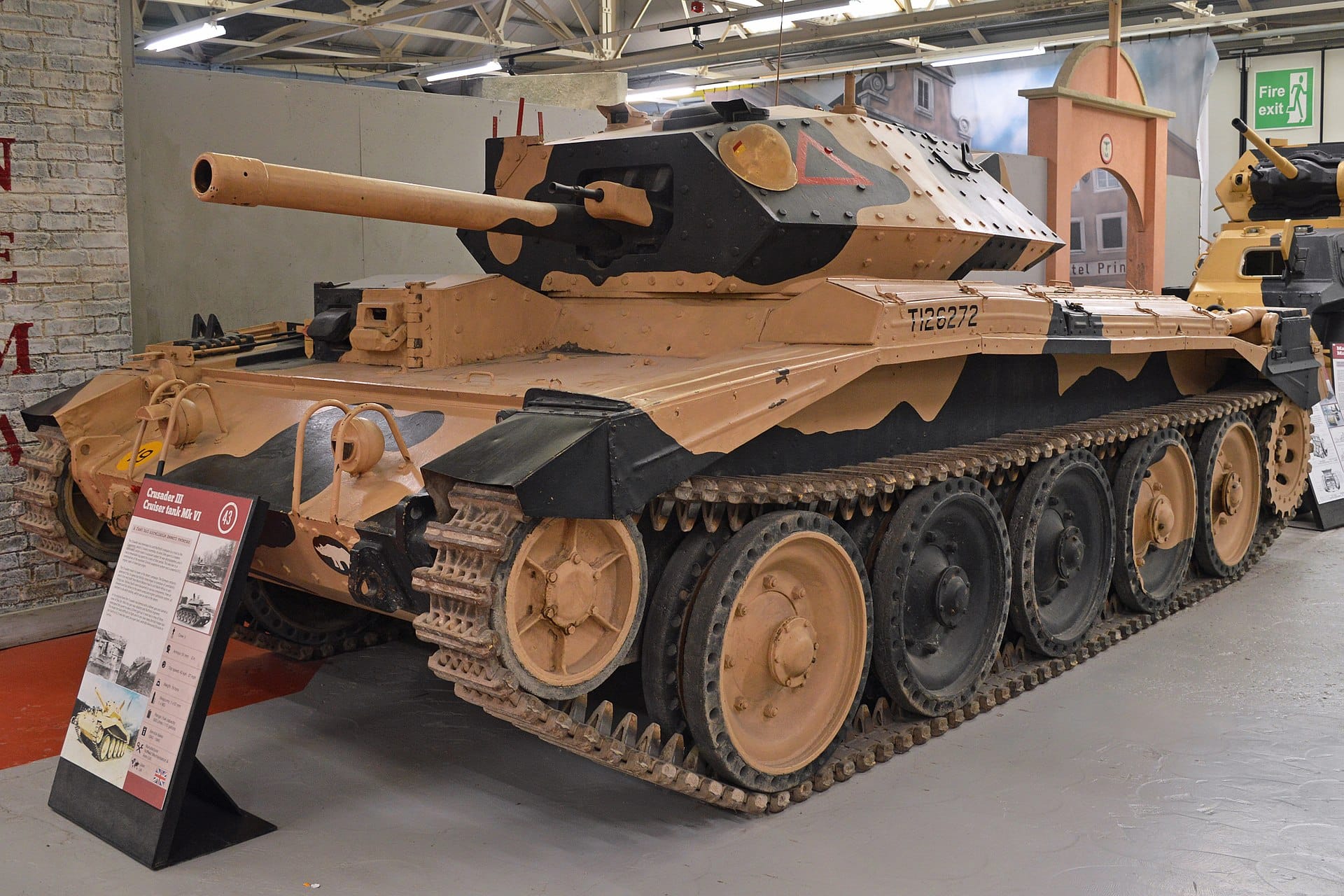American tanks by tradition have borne the names of famous general officers — from Grant and Lee (on the same tank, no less) to Sheridan and Sherman, to Pershing, Patton and Abrams.
The British, on the other hand, tag their tanks with heroic words that start with the letter C. Hence we have had the Challenger, the Chieftain, and the Churchill — in the case of the Churchill Crocodile, we were treated to a double-C — as well as the Centurion and today’s subject, the World War II-era Challenger.
Crusader Tank Early History and Specifications
The Crusader tank — full official name “Tank, Cruiser Mk VI, Crusader” — was initially designed in 1939 and entered into operational service in 1941. It was manufactured by Nuffield Mechanizations and Aero Ltd, which was a personal enterprise of William Morris, 1st Viscount Nuffield.
The Crusader was classified as a cruiser tank, which by definition was one built for speed. It worked independently of the slower infantry tanks. Once a front line was penetrated, cruiser tanks would then speed through to the rear line, attacking lines of supply and communication.
Between the World Wars, tank design had been rather lacking due to funding shortages and a resistance to mechanization — many had viewed the tank as a fad of World War I. Russia had purchased a prototype tank from the American inventor John Walter Christie, who developed a new type of suspension called Christie suspension that allowed tanks to travel at faster speeds cross country. This prototype evolved into the T-34.
The first two variants of the Crusader were lightly armed and armored. Both variants had a mere 40mm main gun — the Ordnance QF 2-pounder — with the Mk 1 sporting 40mm of armor and the Mark II bearing 49mm. The Mark III improved in both areas. It became the first British tank to equip a 57mm Ordnance QF 6-pounder main gun, and it was protected by 51mm of armor. Secondary armament was the Besa 7.92mm machine gun.
Other specifications included a length of 20 feet 8.5 inches, a width of 9 feet 1 inch, a height of 7 feet 4 inches, and a weight of 18.8 to 19.7 long tons. Max speed was 26 miles per hour on paved roads and 15 mph off road.
The Mk I and Mk II Crusaders had a crew of five: commander, gunner, driver, loader, and hull gunner. The Mk III version eliminated the latter two positions.
Combat Performance
In a March 2023 article for Hot Cars ranking the best tanks of World War II, Aaron Young lists the Crusader at a lofty #2, just above the German King Tiger and second only to the French Char B1. (To put things in perspective, he rates the highly touted Soviet T-34/85 at a mere #9.) Here’s Aaron’s rationale:
“The British produced more than 5,000 Crusader tanks during WWII, and it was one of their most common tanks in the North African Campaign — where it significantly contributed to British victories.
“The Crusader Mark 1, the first generation of the tank, was lightly armored and under-armed. However, it was also very maneuverable. Subsequent upgrades saw its flaws remedied, making the Crusader a match for the German Panther tanks of the time.”
The first unit to use the Crusader in combat was the 6th Royal Tank Regiment, which used them alongside Matilda Infantry Tanks.
Eventually the Crusaders were replaced by the American M3 Lee/Grant and M4 Sherman, but they remained in service for training purposes until 1949. Meanwhile, in a testament to the versatility of the basic design, the chassis would serve as the basis of various other platforms, including recovery vehicles, bulldozers, communication nodes, observation posts, fire support, and antiaircraft (“ack-ack”) gun platforms.
Where Are They Now?
Twenty-one Crusaders remain today in various degrees of preservation and wellbeing. There was one in running condition at The Tank Museum in Bovington, Dorset, England, but for whatever reason it is no longer listed as being among the museum’s exhibits. Non-running static displays are viewable at the Musée des Blindés (“Museum of Armored Vehicles”) in Saumur, France, and the Overloon War Museum (Oorlogsmuseum Overloon) in the Netherlands.
Christian D. Orr is a former Air Force Security Forces officer, Federal law enforcement officer, and private military contractor (with assignments worked in Iraq, the United Arab Emirates, Kosovo, Japan, Germany, and the Pentagon). Chris holds a B.A. in International Relations from the University of Southern California (USC) and an M.A. in Intelligence Studies (concentration in Terrorism Studies) from American Military University (AMU). He has also been published in The Daily Torch and The Journal of Intelligence and Cyber Security. Last but not least, he is a Companion of the Order of the Naval Order of the United States (NOUS).
From 19FortyFive
A Russian Submarine Accidently ‘Destroyed Itself’
Total Massacre’: Ukraine Footage Shows Russian Cruise Missile Shipment Attacked

